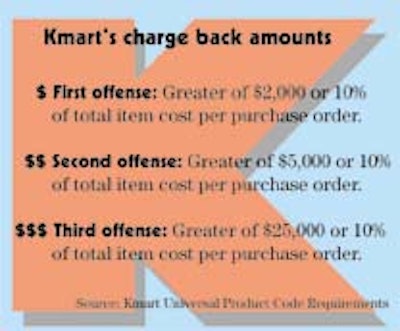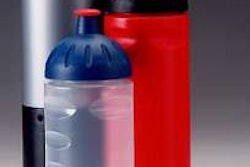Bad bar codes simply won’t fly at Kmart. One of the nation’s leading retailers, Troy, MI-based Kmart offers guidelines to its suppliers to make sure its bar codes are scannable at the checkout.
“The vendor needs to follow UPC guidelines—UPC/EAN or UCC guidelines. It’s definitely a condition of doing business with Kmart,” states Dorothy Brandes, manager, UPC/EAN coordination for Kmart. “The Uniform Code Council has all of its documents on a Web site, and so does Kmart. Of course, I’m an on-site manager, so I can also help with any questions. If they want us to get a little more involved with their symbols, I let them know that they can send it in to me.”
Compliance to these guidelines would seem almost certain. After all, Kmart offers vendors a tremendous retail platform to sell products. Monetary incentives present another compelling reason to comply. As the accompanying chart shows, vendors whose bar codes fail to scan properly may be fined $2ꯠ for the first offense, $5ꯠ for the second and $25ꯠ for the third.
Customer service
Despite Kmart’s compliance “incentives,” violations still exist. Brandes states, “I’ve been with Kmart almost 27 years. Recently, I saw a product from a major manufacturer within the industry that had an identical product. One [version] was ivory, another was white. UPC rules state we need to change the numbers to distinguish the color. The human-readable portions of the codes were different, but the vendor never bothered to change the symbol on the white item. We won’t be able to reorder [the items] because we can’t distinguish the sales of the white product. All the sales are registered to the ivory product.
“Now you have a customer who has purchased the white, but maybe they want to bring it back, but on their register receipt they have the UPC of the ivory.” She continues, “I’m sure they are going to have a hard time at the service counter because the representative is going to say that this isn’t the same item, this is the wrong receipt. This could upset the customer, and we can’t afford to do that.”
Maintaining customer satisfaction is, of course, paramount to success for any business. And Brandes says, “Customer service, especially at the point of sale, is the number one benefit attributable to readable bar codes. We want to make sure that their checkout experience is quick and pleasurable. Our customers could be shopping at a number of retailers. We can’t afford to have poor symbol quality problems.”
Brandes says she can appreciate the customer’s point of view. “I’m a regular Kmart shopper, and when I hear comments from the customers, it’s always perceived that the retailer is at fault. It’s very frustrating to me because I’m a part of this business, and I know exactly what’s going on.”
Fighting the problems
Kmart is not alone in its fight to correct bar-code problems. “We followed right behind Wal-Mart a number of years ago.” she notes Brandes explains, “It’s unbelievable the tremendous amount of heat that we get from vendors that have not made themselves knowledgeable about what’s going on in the industry.”
Brandes feels that the industry is still not as advanced as necessary to identify those problems. “Where I feel that Kmart is a leader is that we capture hand-keyed data at the checkout. I know the number of times a UPC is being entered manually from every one of our stores.”
She says, “The number one error is truncation, which is the shortening of the symbol height. It [affects] the retailers who use flatbed scanners. The scanner is looking for a symbol that is proportionate in height as well as width, so any time you take away half of that height, the symbol has to be more oriented [to the scanner].”
Why is this done? “Probably the graphics people do it so they can hide the symbol,” believes Brandes, “which isn’t such a problem for retailers with hand-held scanners. They have a better chance of getting a first-pass scan. But retailers with flatbed scanners will have problems.”
Certification
Brandes is very much in favor of a certification program like the one that Canada has in place. In the grocery industry there, the vendors have to have the bar codes on their packages certified by one of a number of companies.
The overseer of this program is the Electronic Commerce Code Council (ECCC), which she says is the counterpart of the UCC in the U.S. “This is something that I’m very interested in,” Brandes states. “I’m part of the UCC’s quality workgroup, and we’re looking at some other certification ideas. I’m very much in favor of item-level certification where the vendor would actually go to an independent company to have its UPC certified and that document would then be provided to the retailer.”
See the main story that goes with this sidebar: Bad bar codes provoke retailer penalties


























